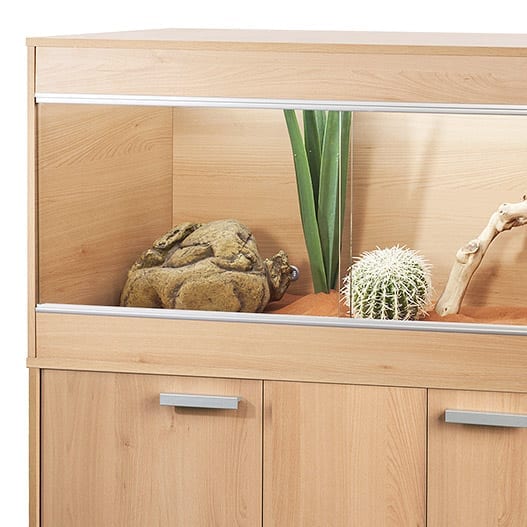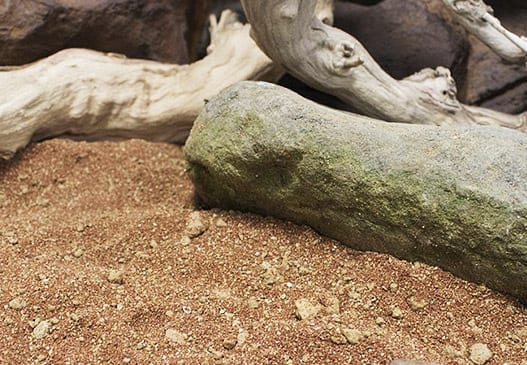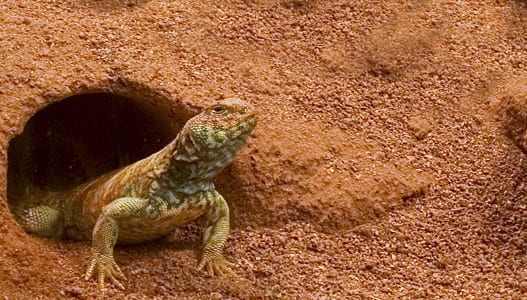Bearded Dragons – Advanced Care
Bearded Dragons are a good starter species for many people. They are resilient to a variety of conditions, however, it is the duty of all keepers to provide the best care possible. We outline various ways of providing their basic needs and some hints and tips on making their lives as enriched, healthy and long lived as possible.
This guide splits their care requirements into six main categories – heating, lighting, diet, substrates, hides and to begin with, housing. As it’s important to consider any species wild natural history, in particular their biotope we have included a section so that the keeper can make an informed decision on the care they provide.
Housing
This species is generally regarded as a ground dweller, but climbing activities (in their wild counterparts) are reasonably frequent – trees, rocky outcrops and walls are commonly climbed. For this reason, whilst it isn’t a vital requirement to provide a particularly tall vivarium, if provided many Beardies will utilise the extra height. An adult will be fine in a vivarium of around 60cm tall, as a minimum – if you plan to add climbing facilities a taller vivarium of around 90cm can be utilised. These sizes can be increased if a deep layer of substrate is planned (see more later). A minimum adult vivarium length should be regarded as around 120cm, more if possible, and if a larger vivarium is preferred always provide plenty of hiding places to allow for security. Babies and youngsters should be scaled appropriately in their housing but keep in mind they grow very quickly and soon require a larger vivarium. There are many styles of vivarium, and many materials they can be made from plastic, fibreglass and melamine all have their bonuses and their negatives.
They are best housed as individuals rather than pairs or groups. If more than one is required a very large vivarium is required to allow natural behaviour. Males will fight, for certain, and it is not unheard of for males to fight with females and even for females to fight with females. Youngsters housed together are prone to tail and toe nipping.

Heating
There are many relationships with the choice of heat source and lighting. This is due to the wild conditions – the sun provides both. We must keep this in mind when choosing a heat source. In the wild the sun provides a basking heat on the Beardies back, once warmed they can then go about their normal activities (feeding, breeding, etc) during the daylight hours. They generally go back to their hides in the evening or during the colder weather in the wild. In captivity this can be achieved by overhead heating (a light emitting bulb or ceramic heater) which will warm the basking Bearded Dragon below. All heaters of any kind should be controlled by a thermostat, for a non-light emitting heater a simple on/off model can be used. However, greater accuracy will be given by a pulse proportional thermostat. Any light emitting heater should be controlled by a dimming thermostat, so there is no constant flashing on and off. Any choice of heater should be placed in the vivarium so there is a temperature gradient – there should be opportunity for the reptile to escape the heat. We aim for around 32-34C in the warm end and 22-24C in the cool end during the day and at night the whole vivarium can drop to around 18-20C. If the keeper is concerned their house ambient temperature drops below this during the night, there are thermostats that will control a day and night temperature – however a light emitting heater is not recommended for use at night – a ceramic heater gives no light.
Lighting
As already discussed, in the wild Bearded Dragons normal activity levels are during the day. It is essential to get their lighting requirements correct for this reason. There are some complex requirements but the three main components for a Bearded Dragon are UVB (so they can use calcium in their diet), full spectrum (the colours of the sun) and also the illuminance level. However, a photoperiod of at least 12 hours day to 12 hours night is vital. This can be altered seasonally if a very natural pattern is preferred. Do not light a vivarium during the night for a Beardie– it needs to be dark; this includes coloured bulbs such as red, green and blue. Incandescent bulbs are poor as a sole source of light and are not entirely recommended as they have a very short life span, give off no UVB and have a poor full spectrum and illuminance levels. Halogens are similar in many ways but a little ‘brighter’ – some keepers like to use these as basking heaters. Mercury vapour are good at giving off UVB and full spectrum and have better illuminance than an incandescent – and metal halide are better again (with some reservations, see separate lighting section). All bulbs, to some extent give off heat – this will need to be controlled by a dimming thermostat.
However, our preference is to provide heat separately in the form of a ceramic heater. This means that bulbs are not required – fluorescent tubes will provide the light elements required. There are two forms of tubes, an older T8 and a much better performing T5. In the older T8 tubes there are three variations – these are known as 2{cb5d0a8cf0c44aef2db327d9ab0dba08dd09aed1126b509e5fa01d3aaa87fe47}, 5-6{cb5d0a8cf0c44aef2db327d9ab0dba08dd09aed1126b509e5fa01d3aaa87fe47} and 10-14{cb5d0a8cf0c44aef2db327d9ab0dba08dd09aed1126b509e5fa01d3aaa87fe47} – this relates to the UVB output and gives an indication of the UVB power. The 2{cb5d0a8cf0c44aef2db327d9ab0dba08dd09aed1126b509e5fa01d3aaa87fe47} is best regarded as a full spectrum tube, rather than a UVB and is really designed to run along side the other two models. The 10-12{cb5d0a8cf0c44aef2db327d9ab0dba08dd09aed1126b509e5fa01d3aaa87fe47} is the best for Bearded Dragons, much depending on how close the Bearded dragon can get to the tube (we suggest no closer than 30cm and use a 12{cb5d0a8cf0c44aef2db327d9ab0dba08dd09aed1126b509e5fa01d3aaa87fe47}). However, the newer T5 are slightly different – there is no requirement for a separate 2{cb5d0a8cf0c44aef2db327d9ab0dba08dd09aed1126b509e5fa01d3aaa87fe47} full spectrum to run alongside the UVB. These tubes provide both. There full spectrum output is wider than a T8, and on top of that their illuminance is far superior – this means the ‘feel good factor’ for the Bearded Dragon is high. This is very important and often overlooked by keepers – it’s not just the important UVB! The UVB output of a T5 also comes in various strengths, 5-6{cb5d0a8cf0c44aef2db327d9ab0dba08dd09aed1126b509e5fa01d3aaa87fe47} and 10-14{cb5d0a8cf0c44aef2db327d9ab0dba08dd09aed1126b509e5fa01d3aaa87fe47} is the commonest. The 14{cb5d0a8cf0c44aef2db327d9ab0dba08dd09aed1126b509e5fa01d3aaa87fe47} is ideal for Beardies that have a mesh topped vivarium and the light mounted on top of the mesh – it will power through the mesh giving good levels of UVB.
Some keepers like to provide a UVB gradient similar to a temperature gradient; however, we suggest areas of shade and hides in the vivarium to allow regulation.
Substrates
Many forms of ground covering substrate have been tried for this species. Many keepers prefer to provide a more natural choice of a sand / soil based loose substrate others prefer sand or newspaper / carpet / lino. All have their good and bad points – but it’s fair to say that the worry of gut impaction is a topic that is fearlessly debated. We have used all methods and recommend ProRep Beardie Life. For further reading see our information sheet on using various substrates.
Water
A small water dish should always be available. However, many young Beardies do not recognise water and for that reason we suggest a light spraying of tepid water, or a dropper, to allow them to lap. Some Beardies will bathe, but many do not.

Hides
Hides must be provided to allow for natural behaviour and security. These can be in the form of commercially available ones, but better to provide homemade deeper hides. This allows the reptile to regulate their exposure and choose the light level they prefer. There are many products that help with homemade hides, such as Zoo Med Excavator Clay, and we will add further guides in using these kinds of products in our substrate information section. It’s important to remember that varying degrees of humidity will be required, and that hides should be placed in various areas within the thermal gradient. If the more advanced method appeals please take a look at our guide to creating more natural humidity creating hides.

Diet
Bearded Dragons are omnivorous and will eat insects and plant matter. Insects for captive Beardies will need to be provided with a large selection of insects such as crickets, locusts, cockroachs, calciworms, mealworms, curly wing flies and waxworms. Variety is the spice of life. Plant matter can be in the form of dandelion, spring greens, rocket, mustard greens, endive, chicory greens, watercress, nasturtium leaves, mallow leaves, plantain leaves and Chinese cabbage. Other foods, in small amounts, can include kale, green cabbage, brussels sprouts and broccoli, spinach, pumpkin, butternut squash and other squashes, green beans, parsnip, carrot, celery, courgettes, red / green bell peppers, grape, banana, raspberry, strawberry, blackberry and mango.
When using commercially available live foods always keep in mind that their diet will need to be artificially supplemented. There are two main methods – one is to use supplement powders and the other is to gut load the live food (some keepers utilise both). Take a look at our guides for the use of supplements and gut loading in our general advice section. Veggies can also be supplemented with multi-vitamin and calcium powder.
It is important to remember that this species comes from a harsh environment food is not always available. At certain times of the year insects are not plentiful, and vegetation burnt off by the powerful sun. For this reason, they are prone to be overfed in captivity resulting in obesity and periods of starvation.
Biotope
A good starting point is where this species occurs in the wild. It occurs in large areas throughout arid scrubland areas in central and eastern inland parts of Australia. The range does extend in semi-desert regions. These regions are very hot during the summer, with temperatures that can get as hot as 40-44C during the hottest part of the day, with cool to cold temperatures at night – varying through the range but can be in single figures. Humidity is very low during the day, but often higher once retired into their hides at night. They are active after the sun comes up, coming out of their hiding areas to bask. Once warmed sufficiently they will then spend the day eating, defending themselves, breeding, climbing and other similar Beardie activities. This means they will go back to basking in full sun shine to ‘recharge their batteries’ and then be in and out of full sunshine for the rest of the day. Their night time hides can be on the ground, or in higher in rocky outcrops, they will also make their own burrows by digging – this provides varying levels of humidity and moisture.
In the wild they would generally hibernate (brumate) in the cooler months, and aestivate during the hot extremes of the year. This is linked with the over eating problems / periods of not feeding well known for this species. Many captives will follow a similar pattern to their wild counterparts.
Beardies are not strictly a colony species, but several will live in close proximity of each other. They have ways of communicating with each other, with various head bobbing and arm waving. Males will not tolerate each other and will aggressively fight.
This guide is designed to be used in conjunction with the help and advice given during your personal consultation at Coast to Coast Exotics. Please allow at least an hour for us to cover the many details we feel.
